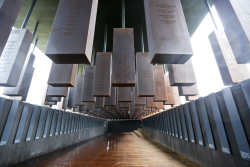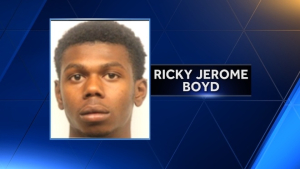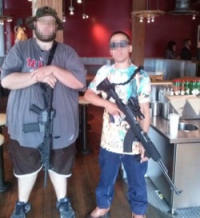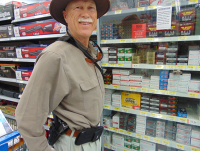
Its proper name is the National Memorial for Peace and Justice. The Equal Justice Initiative built it, and an accompanying museum, on a six acre site at Centennial Hill in Montgomery, Alabama , near where I-85 meets I-65. It is just a few blocks from the first White House of the Confederacy, the Rosa Parks Museum, and the Hank Williams museum.
Call it the duality of the southern thing.
There are 313 names inscribed there, on tombstones that also bear the names of counties across the South where men were murdered during the days of Jim Crow. There are two sets of tombstones, and the museum hopes this second set will eventually be picked up by those counties, creating memorials to the dead there.
It is, without question, the most moving monument built in America since the Vietnam Veterans Memorial was opened in 1982.

Ricky Boyd was shot outside his grandmother’s house in Savannah, Georgia in January. Police first said he shot at them, then that he had a BB gun. The gun was 45 feet away.
What is remarkable about the case is that it is unremarkable.
Police are shooting unarmed black men, almost routinely, and the people who document such things are being attacked. Sometimes the men are being beaten within an inch of their lives. Sometimes, these people die. Courts are routinely ignoring the violence.

What’s the difference between what is happening today, murders committed under color of law, and the situation 100 years ago, when armed KKK hoodlums terrorized black communities, and police often participated in the hangings?
Only the costumes.
We don’t call what is happening now “lynching” because crowds of hooded men with burning torches aren’t beating and then hanging people in grainy, black and white photographs. But a beating and multiple gunshots from a man in a uniform, shown on a full-color digital film, leave you just as dead.
When a white man named Travis Reinking shot up a Waffle House recently, and was arrested after a 34 hour manhunt, the judge first tried to release him on bail. He had previously been arrested at the White House, where four guns were confiscated and given to the man’s father, who gave them back.
This is not equal justice under law.

White people say they have a right to openly carry machine guns into a Walmart, but if a black man even is felt to be carrying some sort of weapon he can be shot dead? If a half-dozen black men walk into a Walmart openly carrying guns, as this man is shown carrying, and claiming their “rights” under the Second Amendment, do you really think they will get out alive?
That is what makes the Montgomery monument unique in the history of the world. It doesn’t commemorate history. It memorializes something that is still happening.
The Civil War is still being fought. Right now, it is being lost.
It is the obligation of every white person, of me, of you, to history, to use every legal means at our disposal to make certain the Civil War isn’t lost. That doesn’t just mean working against Trump, or against Congress, but against every state legislator, judge, prosecutor or rogue cop involved in this. You have no right to ask why Germans didn’t stand up to Hitler in 1938, when cops are killing unarmed men down the street from you and you’re doing nothing about it.
Then, after this war is over, we need more names put on more monuments, in more cities, to remind our grandchildren and their grandchildren, 100 years from now, that Never Again means never to anyone.









